
Atlas F1 Technical Writer
After all of the talk about rule changes and politics, Formula One finally reopened for business this weekend in Melbourne. Atlas F1's Craig Scarborough reviews the regulation changes and the technical improvements made by the teams in Australia, and how both affected the results of the opening race
Warmer weather on the two previous days lead the teams to be wary on cooling, with many cars arriving on the grid with cooling packages already nominated to the FIA scrutineers as a result of the new parc ferme rules. Many teams showed off their new cooling ducts and chimneys for the first time, and the split between those with dedicated outlets and the others which shared with the exhaust tail pipe was pretty even between the teams.
Along with cooling several new wing packages were seen, many tested just prior to flying off for the race. As mentioned in last week's preview rear wings that form a more complex shape were favoured for their low drag qualities.
Weekend and wet weather strategies
For this race at least the teams opting for limited testing were given an advantage by the extra running on Friday morning. This session give the relevant teams a chance to complete installation runs on all of their cars, including the spare car, which is problematic for the remaining teams over a race weekend given the new format. Installation runs check for problems on the car that have occurred in setting up or in transit. Loose parts and leaks are the most common faults, and these slower laps also allow the driver to test the car-to-pits radio reception at various points around the circuit.
After this the teams concentrated on tyre and set up programs, more usually dedicated to the un-timed session later on Friday mornings. Renault was the only team to run an extra car (in the hands of Allan McNish) to gather additional data. Problems with McNish's car lead the tyre program to change, and McNish completed long runs assessing tyre degradation. With the extra two hours of running these teams were ahead of the remainder of the field when the first open practice started later that morning.
Throughout this session, and going into the first qualifying session, teams were careful to keep the cars running and get the car back to the pits when problems arose. BAR had a pair of Honda engine failures, leaving the cars out on circuit and Villeneuve without any representative running, while Williams had some hydraulic problems. Despite the lack of running the teams found the track was less green than usual for the first session, with McNish commenting that the track had more grip than usual after only the first hour of the early morning session.
From this session the weekend strategy would really kick in, with the first qualifying session (Q1) decides the running order on Saturday; it is assumed that the later a driver runs on Saturday the better. Hence the teams would run flat out for the Q1 session, which led to many drivers overdriving. Several drivers found judging the braking zone for turn 1 particularly tricky, with understeer leading to their cars running wide into turn 2.
With the order decided for Saturday's decisive second qualifying (Q2) session there was only one open session to decide the cars fuel, tyres and set up for it (and the race). In this session there were plenty of off-track excursions, leading to substantial damage to Raikkonen's and Schumacher's cars. While Raikkonen's car was too damaged to continue (he was eventually allowed to run in the spare car) Michael kept his car going, returning to the pits effectively on three wheels with the left front flailing around on its tethers and broken wishbones. The damage was repaired, and he used the car for the balance of the weekend.
Several drivers fell victim to car problems, including Juan Pablo Montoya with a smoky engine and the Jaguars with brake problems. The Q2 session saw drivers at a different pace to that shown in Q1 as the fuel load was increased in readiness for the race, as well as differing driver reactions to the single lap run. Minardi found a loophole in the regulations, and given that they expected to qualify last anyway they decided to abort their flying laps and re-enter the pit in order to have access to their cars through the evening to better prepare for the race. We can expect some clarification to the rules to prohibit this practice.
The result was a shaken up grid, which gave little idea as to who had problems on the flying lap, bigger problems overall, or were simply running heavy with fuel. Afterwards run the cars were put in parc ferme and left until two hours before the race. During this period the cars can have limited work carried out on them; obvious crash damage can be repaired, cooling chimneys added and the cars given a quick clean. Right up to the race start work was being done on the cars; after the parade lap Raikkonen entered the pits in order to get new tyres and a top up of fuel.
Those who started on slicks (Both Williams drivers, Panis, Trulli, Verstappen) made the right judgement, with those who pitted early (Raikkonen, Coulthard, Villeneuve, Button) also calling a good strategy. Ferrari and several others remained on intermediates long after the others were lapping faster with their slicks in order to stretch out their first stint to make better use of a heavy fuel load; this plan ultimately failed as the track was dry within a few laps and no more rain fell.
Design
Rear wings
A new feature of at least four teams was the innovation of 3D or delta rear wings. The teams make the outer sections of the main wing smaller; these run in cleaner air, not disrupted by the airbox and rollover structure. The wings outer profiles are shorter by means of a shorter chord (length front to rear) and higher camber (angle of attack). As a result the wing can produce as much downforce as a conventional wing but with less drag, making them more efficient on medium downforce circuits.
Cooling
With high temperatures being normal for Melbourne, and the new rules demanding that cooling ducts are pre-nominated before qualifying to the scrutineers, many teams ran over-large cooling set ups for the race, although it was useful all the same to get race reliability for these appendages before the hottest races of the year coming up in Malaysia and Brazil.
In previous years simply cutting a section out of the coke-bottle area was sufficient to improve cooling, but this came at the expense of aerodynamics and teams have started to add dedicated outlets. These are placed either ahead of the rear wheel and shaped with the flip-ups or added to the top of the engine cover and shaped like a chimney. The flip-up solution is bulky and cannot be easily changed, while the chimney set up is neat and expels the air above the flow that leads to the lower rear wing mount. Ferrari have now added this chimney to the exhaust outlet; this tidy solution also has the benefit that the energy from the exhaust pipe flow actively pulls the hot air from within the sidepods, aiding cooling at lower speeds.
Team by Team
McLaren
Despite being one of only two teams running older cars McLaren had the most changed car from winter testing; it was heavily altered from the cars final shakedown at Silverstone. They raced for the first time with a clutch-less set up; while this did not do away with the clutch itself it did negate the need for clutch paddles on the steering wheel. With all clutch movement being managed by the electronics leaving the pits, at the start of the race and in the event of a spin, this system may be banned when further rule changes come into effect at the Silverstone race.
Aerodynamically the car did not debut its flatter "W" format front wing, instead using a flat curved wing developed in 2002. Not seen even in testing was the new bargeboard/keel layout; up until now the McLaren ran with large mid-placed bargeboards and keels extending to the ground with two trailing panels. This complex set up has been deleted, leaving small, low mid-placed boards and a smaller one-piece trailing panel from the keel. This layout creates less drag, and requires a front wing creating more downforce and fewer disturbances to the airflow going over the car. As previously mentioned the car ran the new delta rear wing and notched endplate.
Williams
Mixed reports from the Williams team about the cars performance raised speculation as to where their main problem lay, and how bad it was. Aerodynamic performance has been suggested as the weak point, but mechanical issues are still mentioned. Appearing with the traditional forward placed bargeboards since early testing, the car runs with a flat front wing and new for 2003 delta rear wing. Cooling for the race was aided by large exhaust chimneys wrapped around protruding exhaust tailpipes.
A new gearbox package was seen earlier in the weekend, although it has not been confirmed whether it was run in the race. The new gearbox uses the old internals with a revised casing in order to package the rear suspension differently. Williams have used coil springs to support the rear suspension for many years, but have now created a torsion bar layout. With torsion bars placed longitudinally and point slightly downwards, the team now places the dampers inside the gearbox casing and operates a third damper over the top of the linkage. This is a major departure for Williams, and places them closer to Ferrari and McLaren in terms of rear suspension layout.
Throughout Friday and Saturday the Williams drivers struggled with the car and failed to post quick lap times. In the race good strategy reversed the team's fortunes, pushing Montoya to the front, while a delayed pit stop caused by a stuck rear wheel hampered Schumacher's progress. Montoya's late race spin was self-admittedly a driver error, and cost him a win.
Ferrari
Renault
Renault ran their new aero package, which consisted of a new front wing with Toyota-like endplates, raised exhaust outlets, new winglets and flip ups. Added running with three cars in the Friday morning test session improved their progress, and Q1 times were fast despite low speed trap figures of 308kmh for Trulli and only 303 kmh for Alonso, in comparison to 312-315 kmh for the top teams. Both drivers over-drove the car in Q2, with an assortment lock ups, slides and over-running corners. This pushed the car down the grid, which worked against their planned race strategy, as the cars were to run with a lot of fuel for a long opening stint.
After parc ferme released the cars for the race work was needed to both cars on the electronics, with Alonso also requiring a new steering wheel. A gamble on opening tyre choices for Renault saw both drivers on Michelin slicks, and the cars had the pace of the field for the opening stint. Clean racing for both drivers brought both home in the points.
Sauber
Sauber ran unchanged from their recent testing spec, and appeared to adapt well to the new rules. The car seemed to handle well, and posted faster speed trap figures (308 kmh) than close rivals Renault. Middling Q1 times lead to two strong Q2 runs, with Frentzen running eighth in the session Heidfeld outpacing him until an error in sector 3 lost him a couple of tenths. The drivers qualified a creditable fourth and seventh, prompting the belief that a three-stop run was planned for the race. Early stops from intermediates to slicks in the race pushed the fast starting Saubers down the order before Heidfeld locked up into turn 13 and ran off, almost taking Ralf Schumacher off in the process. With more pitstops then the front runners Frentzen went on to finish sixth.
BAR
Most of the BAR aerodynamic configuration has been previously explained in the review. Friday morning's practice session saw both cars have engine failures for the new spec Honda engine; this new spec engine was supposedly lighter and more powerful than the version run in the majority of testing. As there were only six new spec units available Button was dropped to the older spec for the remainder of the weekend.
In the Q1 session, Button ran first in the team by right of his higher championship placing last year. Despite over-running turn 1 slightly his first sector was fastest so far, although he lost out a little at the end of the lap. Villeneuve had not run enough to judge accurate braking points, especially into turn 1, and information from Button's earlier lap being fed back to Villeneuve. His lap was ragged, but he kept his sectors times consistent enough to outpace his teammate. Button ran first in Q2 and pushed hard, keeping his sectors time competitive. Villeneuve went out two cars later and his lap was messy, with a run over the kerbs at Turn 4 and the traction control cutting in heavily on the exit to corners. Even his top speed at 305kmh was poor, but he somehow came out two tenths up on Button.
After Parc Ferme, Button needed his steering rack replaced, and both drivers left the grid on Bridgestones intermediates. They pitted early (laps 3 and 4) for slicks, although a reported radio failure meant both cars arrived at the pit simultaneously on lap 25. Villeneuve had been called in for several laps, and mistook Button's pit board for his own. This error, and the three-stop strategy, pushed the otherwise competitive BARs down the order, with Button in particular suffering due to the pit error. At race end reliability saw the cars come ninth and tenth, just out of the new points places.
Minardi
With the expected lack of changes to the car from testing Minardi had to resort to strategy to get ahead this weekend. The extra practice allowed both drivers to get used to the car, and new boy Wilson covered 30 laps in this session. Going out for his Q1 lap Wilson had some initial throttle problems which were cured by his flying lap. A clean lap with a respectable 307kmh speed trap figure still saw him qualify last. Verstappen had a similar run to lap over four tenths faster.
Both drivers aborted their Q2 runs to allow the cars to be worked on overnight for the race; this strategy was accepted by the race stewards, and with the poor weather before the race the gamble looked to be paying off. The team predicted more rain, and used their open access to the cars to apply a wet set-up to the cars; this tactic failed with the race drying out. Later in the race radiator problems saw Wilson's car worked on in the pits for several laps, while Verstappen's pit stop was slowed by his struggle to engage a gear to when leaving the pit. Wilson ultimately retired, while Jos ran until the end of the race.
Jordan
Behind the tidy airbox and cooling system is an all-new gearbox, which uses a carbon fibre section to mount the coil-sprung dampers and roll bars. The gears are still contained within a metal casing, and the wishbones mount to this metallic part of the casing. Having the hybrid construction lowers the overall weight, and the much lighter weight of carbon fibre high in the gearbox lowers the centre gravity. Under the gearbox is a huge slab of ballast shaped to fit neatly within the cut out in the floor. This neat rear end set up brought admiring glances from Ron Dennis while it was sat without its bodywork on the grid before the race.
While the design is neat the cars handling was dominated by understeer on Friday. Both drivers lacked confidence on turn-in, and over-shot Turn 1 on their Q1 laps. The customer spec Ford CR4 engine failed to propel the cars quickly down the straight, clocking a speed of 305kmh. Firman's Q2 lap still carried a lot of understeer and he made some driving mistakes, while Fisichella turned the understeer to oversteer and looked spectacular, if not fast, on his lap. In the race Firman followed Barrichello off the circuit at Turn 13, while Fisichella trailed most of the field in the race until a misfire saw him pit to retire on lap 52.
Jaguar
With a car unchanged from its testing specification Jaguar lacked pace and poise all weekend, with the new drivers feeling the pressure and producing poor performances. Pizzonia especially struggled in the one lap qualifying runs, despite a good reputation as a steady test driver.
In Q1 Webber ran first and understeered wide at Turn 1, losing a further two tenths over the balance of the lap, while Pizzonia had a worse lap; stiff and jittery, he locked the brakes and made several trips over the kerbs. His problems continued with brake problems spinning him off the track on Saturday morning, and in Q2 he made more errors, getting on the dirt on the outside of corners and posted a slower time than on Friday. Webber was blighted with understeer for his Q2 run, and lost time in the middle sector. Qualifying in P14 and P18 the team opted for slicks to start the race, with Webber progressed well until retirement on track, a fate which also befell Pizzonia later in the race.
Toyota
No new developments were visible on the car this weekend, and the team had a strong winter testing reputation to live up to. The first Q1 lap fell to Panis, who ran quickly despite a nervous and stiff looking front-end, while his team mate ran last in the session and amazingly for his first timed run in an F1 car turned a blindingly fast first pair of sector times before he made an error, running wide into the last sequence of corners and losing nearly a second. Da Matta's pace carried over into Q2; an error in turn 1 did not lose him much time, although more problems lost him half a second in sector 2 before a clean sector 3 regained the lost time as he found himself almost catching a slowing Nick Heidfeld. Panis put in three consistent sectors and a speed trap figure of 310kmh to post the fifth fastest time.
Panis' F1 experience lead him to start on slicks with da Matta opting for intermediates before he spun out of the race trying to overtake on the inside into turn 1. The safety car came out for other accidents and Panis pitted, and he seemed to lose pace throughout the balance of the race. He made a pitlane exit infringement, leading to a drive through penalty, and finally retired out on the circuit.
The race result in Australia had little to do with the effect of the new rules; unpredictable weather on race day lead to a split in the teams on whether it would rain again or dry out for the race, and their subsequent tyre strategies. Teams which faired poorly in the second decisive qualifying session were tempted to gamble on this strategy, and it paid off for several teams.
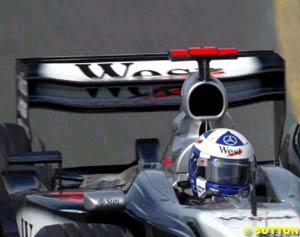 The race strategy decided at Saturday lunchtime now had an extra variable; the rain that began to fall an hour before the start. Teams had to decide whether it would rain again or if the strong wind would dry the track quickly, then put this prediction into their predefined race strategy in order to outfox their rivals. Teams that had opted for long opening stints were handicapped, as their cars would be heavy with fuel and with drying conditions could be forced to take an early stop.
The race strategy decided at Saturday lunchtime now had an extra variable; the rain that began to fall an hour before the start. Teams had to decide whether it would rain again or if the strong wind would dry the track quickly, then put this prediction into their predefined race strategy in order to outfox their rivals. Teams that had opted for long opening stints were handicapped, as their cars would be heavy with fuel and with drying conditions could be forced to take an early stop.
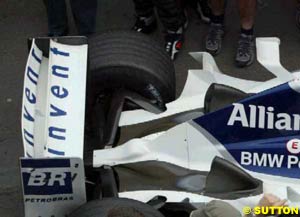 The last element of the weekend strategy was wing levels. Many drivers had lower wing levels than they would have liked for wet weather, but as the track dried and cars with significantly different fuel loads and tyre wear fought for position the drivers with low wing levels found they could out-drag those with higher wing levels (also decided before Q2) easily along the straight. Judged by the eye it could be said the Ferraris had a lot more wing than their rivals; this must have prevented the faster (overall) Ferrari from overtaking cars as it recovered from its pit stops and spins.
The last element of the weekend strategy was wing levels. Many drivers had lower wing levels than they would have liked for wet weather, but as the track dried and cars with significantly different fuel loads and tyre wear fought for position the drivers with low wing levels found they could out-drag those with higher wing levels (also decided before Q2) easily along the straight. Judged by the eye it could be said the Ferraris had a lot more wing than their rivals; this must have prevented the faster (overall) Ferrari from overtaking cars as it recovered from its pit stops and spins.
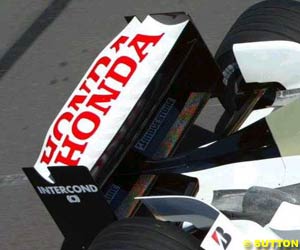 McLaren debuted their wing this weekend; it uses a bi-plane arrangement with the two stacked leading elements having stepped outer sections, while the rear flap is straight and the endplate has a triangular cut out as seen on their conventional wing last year. BAR had a similar wing although the rear edges of the wing are shortened, in addition to the triangular cut out on the endplate seen for several years on the BAR. Jordan and Williams use only a shaped rear element and no cut outs, along with Renault (who used their wing last year), and they also have a McLaren format stepped wing which was seen in testing but not run this weekend.
McLaren debuted their wing this weekend; it uses a bi-plane arrangement with the two stacked leading elements having stepped outer sections, while the rear flap is straight and the endplate has a triangular cut out as seen on their conventional wing last year. BAR had a similar wing although the rear edges of the wing are shortened, in addition to the triangular cut out on the endplate seen for several years on the BAR. Jordan and Williams use only a shaped rear element and no cut outs, along with Renault (who used their wing last year), and they also have a McLaren format stepped wing which was seen in testing but not run this weekend.
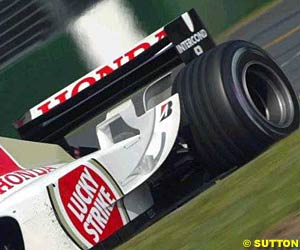 Cooling outlets for the current field centre in three areas, with the rear end of the sidepods being left open to form the main escape for heated air passing over the radiators and engine, but this shape is fixed and needs extra outlets to tune the car to the weather. Too many outlets creates drag, slowing the car on the straights, while too few outlets means the car overheats and blows its engine.
Cooling outlets for the current field centre in three areas, with the rear end of the sidepods being left open to form the main escape for heated air passing over the radiators and engine, but this shape is fixed and needs extra outlets to tune the car to the weather. Too many outlets creates drag, slowing the car on the straights, while too few outlets means the car overheats and blows its engine.
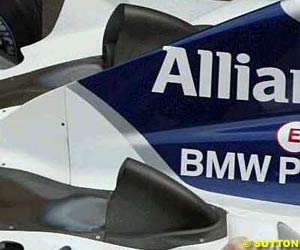 Many team have adopted these combined chimneys (Williams, Toyota, Sauber and Minardi). Renault retains conventional (albeit curvy) chimneys, as do Jordan. McLaren, Jaguar and BAR have adopted the flip-up format, with BAR in particular having created a large detachable panel to mount both the cooling outlets and sidepod winglet. This allows BAR to run a flip-up cooling outlet when it's hot, or have a cleaner sidepod shape when it's cooler.
Many team have adopted these combined chimneys (Williams, Toyota, Sauber and Minardi). Renault retains conventional (albeit curvy) chimneys, as do Jordan. McLaren, Jaguar and BAR have adopted the flip-up format, with BAR in particular having created a large detachable panel to mount both the cooling outlets and sidepod winglet. This allows BAR to run a flip-up cooling outlet when it's hot, or have a cleaner sidepod shape when it's cooler.
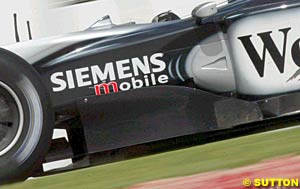 Despite good runs in Q1, Q2 was ruined by a poor lap for Coulthard and a wild lap by Raikkonen (who had several trips off the racing line and finally a punctured rear tyre). In the race clever use of wet race strategy put both drivers at the front, with a pit lane speed infringement by only 1kmh leading to Raikkonen's drive-through penalty, while Montoya's spin put Coulthard in the lead for the final stint of the race.
Despite good runs in Q1, Q2 was ruined by a poor lap for Coulthard and a wild lap by Raikkonen (who had several trips off the racing line and finally a punctured rear tyre). In the race clever use of wet race strategy put both drivers at the front, with a pit lane speed infringement by only 1kmh leading to Raikkonen's drive-through penalty, while Montoya's spin put Coulthard in the lead for the final stint of the race.
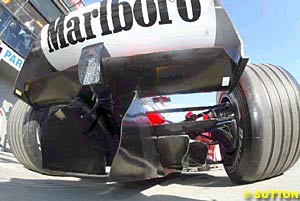 With the revised F2002 appearing largely unchanged from winter testing they had the dry weather pace of the field. Offs for both drivers during the weekend suggested the car was not as balanced as they would have liked, and in the race the over-large rear wing slowed Michael's speed on the straight, as did the two-stop pit strategy. Late race offs for Michael damaged his floor and bargeboards, putting paid to his chances of overtaking for a podium position.
With the revised F2002 appearing largely unchanged from winter testing they had the dry weather pace of the field. Offs for both drivers during the weekend suggested the car was not as balanced as they would have liked, and in the race the over-large rear wing slowed Michael's speed on the straight, as did the two-stop pit strategy. Late race offs for Michael damaged his floor and bargeboards, putting paid to his chances of overtaking for a podium position.
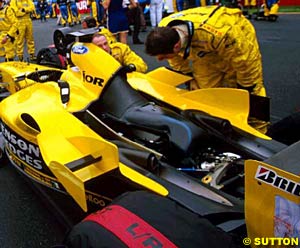 Having had a quiet winter and some low profile running in testing, the Jordan appears to be a more advanced car than meets the eye. Under the sidepods compound angle radiators are placed ahead of a periscope exhaust system and a remarkably low airbox; most of the visible section of airbox is in fact a duct to feed cool air to the gearbox oil cooler. While airbox volume is important, most of its performance comes firstly from the ram effect created by the fast flowing air entering the inlet and secondly by the interaction with the inlet trumpets, which boosts the amount of fuel and air the engine can breathe in.
Having had a quiet winter and some low profile running in testing, the Jordan appears to be a more advanced car than meets the eye. Under the sidepods compound angle radiators are placed ahead of a periscope exhaust system and a remarkably low airbox; most of the visible section of airbox is in fact a duct to feed cool air to the gearbox oil cooler. While airbox volume is important, most of its performance comes firstly from the ram effect created by the fast flowing air entering the inlet and secondly by the interaction with the inlet trumpets, which boosts the amount of fuel and air the engine can breathe in.
Please Contact Us for permission to republish this or any other material from Atlas F1.
|
Volume 9, Issue 11
Atlas F1 Exclusive
The Taming of the Shrewd
Articles
Raising the BAR (II)
Ann Bradshaw: View from the Paddock
Australian GP Review
The 2003 Australian GP Review
Technical Review: Australian GP
Reflections on Melbourne
Saved by a Shower
That's Entertainment!
Stats Center
Qualifying Differentials
SuperStats
Charts Center
Columns
Season Strokes
Elsewhere in Racing
The Weekly Grapevine
> Homepage |